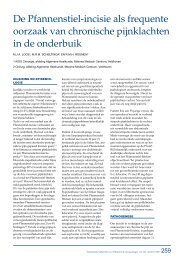Surgical management of chronic inguinal pain syndromes - Liespijn
Surgical management of chronic inguinal pain syndromes - Liespijn
Surgical management of chronic inguinal pain syndromes - Liespijn
Create successful ePaper yourself
Turn your PDF publications into a flip-book with our unique Google optimized e-Paper software.
effect <strong>of</strong> neurectomy on occupational disability is annoyingly insufficient. Non-surgicaltreatment results with reference to return to work in <strong>chronic</strong> postherniorrhaphy <strong>pain</strong>patients are virtually nonexistent. In general, these effects on occupational disabilityare not mentioned at all. In a recent retrospective study by Bright et al. the majority <strong>of</strong>patients attending a <strong>pain</strong> clinic were discharged <strong>pain</strong>-free after a 1-year period 35 . It isobvious that due to a lack <strong>of</strong> major studies on non-surgical treatment regimes theeffect on <strong>chronic</strong> <strong>pain</strong> resolution and occupational disability also remains unclear.The present study demonstrates that, based on a recently published registry <strong>of</strong> neurectomypatients 18 , over 50% <strong>of</strong> the patients went back to work. Moreover a lot <strong>of</strong> patientswere occupationally disabled even before their <strong>inguinal</strong> hernia repair due to otherreasons. So, on the one hand there is a definite <strong>pain</strong> reductive effect <strong>of</strong> our treatment,but on the other it does not always result in alleviation <strong>of</strong> the occupational disability ineach patient. Moreover, some patients continued to work despite severe <strong>pain</strong> complaints.Our success rate may seem somewhat lower compared to earlier mentioned successrates, but is probably a more realistic one. An overestimation in previous studies due toabsence <strong>of</strong> in- and exclusion criteria as well as inaccurate measurement <strong>of</strong> disability orincomplete follow-up may possibly explain this discrepancy. In contrast, a 50% successrate is much higher when compared to percentages observed in other causes <strong>of</strong> occupationaldisability (e.g. <strong>chronic</strong> musculoskeletal problems). In the Netherlands, only 10%<strong>of</strong> the occupationally disabled patients will eventually get back to work, <strong>of</strong>ten by means<strong>of</strong> an intensively subsidized reintegration project 36 . Despite the lack <strong>of</strong> large and uniformlyconducted studies, operative neurectomy appears to provide a substantial reduction inoccupational disability in most patients suffering from severe postoperative <strong>inguinal</strong> <strong>pain</strong>.Occupational disability due to <strong>inguinal</strong> neuralgia is associated with major workerscompensational costs. A tailored neurectomy can save over €1.6 million per year in theNetherlands alone. As most patients are disabled for many years, these costs arecumulative. Since <strong>chronic</strong> postherniorrhaphy neuralgia is encountered all over the world,an enormous cost reduction can be accomplished globally with adequate treatment.Another aspect <strong>of</strong> occupational disability is the increased medical consumption forother health issues, which generates high costs as well 21 .The present study has certain limitations. A drawback includes the small number <strong>of</strong>studied patients. Moreover, a totally reliable cost-benefit analysis is impossible due toabsence <strong>of</strong> previous studies on this subject. In future studies occupational disabilityshould be taken into account as a standard outcome measure for treatment regimes.We also strongly feel that most patients are currently inadequately treated for severe<strong>inguinal</strong> <strong>pain</strong> complaints. A ‘tailored neurectomy’ is obvious beneficial for most patientsalthough some issues remain unsolved including timely referral patterns to <strong>pain</strong>clinics as well as the effects <strong>of</strong> non-surgical treatment on occupational disability. Theoretically,it may be possible that some patients are treated with adequate <strong>pain</strong> reductionwithin one year <strong>of</strong> non-surgical treatment.In conclusion, neurectomy is an effective treatment modality for the resolution <strong>of</strong>occupational disability due to postherniorrhaphy <strong>inguinal</strong> neuralgia. Results on nonsurgicaltreatment options are unavailable. Neurectomy probably greatly reducesworkers’ compensational costs. Worldwide an enormous cost-reduction can be accomplishedwith adequate treatment.REFERENCES1 Bay-Nielsen M, Perkins FM, Kehlet H. Pain and functional impairment 1 year after <strong>inguinal</strong>hernior-rhaphy: a nationwide questionnaire study. Ann Surg 2001; 233: 1-72 Loos MJ, Roumen RM, Scheltinga MR. Chronic sequelae <strong>of</strong> common elective groin hernia repair.Hernia 2007; 11: 169-1733 Nienhuijs S, Staal E, Strobbe L, Rosman C, Groenewoud H, Bleichrodt R. Chronic <strong>pain</strong> after meshrepair <strong>of</strong> <strong>inguinal</strong> hernia: a systematic review. Am J Surg 2007; 194: 394-4004 Loos MJ, Roumen RM, Scheltinga MR. Classifying post-herniorrhaphy <strong>pain</strong> <strong>syndromes</strong> followingelective <strong>inguinal</strong> hernia repair. World J Surg 2007; 31: 1760-17655 Hindmarsh AC, Cheong E, Lewis MP et al. Attendance at a <strong>pain</strong> clinic with severe <strong>chronic</strong> <strong>pain</strong>after open and laparoscopic <strong>inguinal</strong> hernia repairs. Br J Surg 2003; 90: 1152-11546 Hamer<strong>of</strong>f SR, Carlson GL, Brown BR. Ilio<strong>inguinal</strong> <strong>pain</strong> syndrome. Pain 1981; 10: 253-2577 Maaliki H, Naja Z, Zeidan A. Repeated ilio<strong>inguinal</strong> block using a catheter technique for <strong>pain</strong>relief in <strong>inguinal</strong> neuralgia. Pain Pract 2008; 8: 144-1468 Rauchwerger JJ, Giordano J, Rozen D, Kent JL, Greenspan J, Closson CW. On the therapeuticviability <strong>of</strong> peripheral nerve stimulation for ilio<strong>inguinal</strong> neuralgia: putative mechanisms andpossible utility. Pain Pract 2008; 8: 138-1439 Cohen SP, Foster A. Pulsed radi<strong>of</strong>requency as a treatment for groin <strong>pain</strong> and orchialgia. Urology2003; 61: 64510 Rho RH, Lamer TJ, Fulmer JT. Treatment <strong>of</strong> genit<strong>of</strong>emoral neuralgia after laparoscopic <strong>inguinal</strong>herniorrhaphy with fluoroscopically guided tack injection. Pain Med 2001; 2: 230-23311 Rozen D, Parvez U. Pulsed radi<strong>of</strong>requency <strong>of</strong> lumbar nerve roots for treatment <strong>of</strong> <strong>chronic</strong> <strong>inguinal</strong>herniorraphy <strong>pain</strong>. Pain Physician 2006; 9: 153-15612 Aasvang EK, Kehlet H. The effect <strong>of</strong> mesh removal and selective neurectomy on persistent postherniotomy<strong>pain</strong>. Ann Surg 2009; 249: 327-33413 Amid PK. Causes, prevention, and surgical treatment <strong>of</strong> postherniorrhaphy neuropathic inguinodynia:triple neurectomy with proximal end implantation. Hernia 2004; 8: 343-34914 Bower S, Moore BB, Weiss SM. Neuralgia after <strong>inguinal</strong> hernia repair. Am Surg 1996; 62: 664-66715 Giger U, Wente MN, Buchler MW, Krähenbühl S, Lerut J, Krähenbühl L. Endoscopic retroperitonealneurectomy for <strong>chronic</strong> <strong>pain</strong> after groin surgery. Br J Surg 2009; 96: 1076-108116 Heise CP, Starling JR. Mesh inguinodynia: a new clinical syndrome after <strong>inguinal</strong> herniorrhaphy?J Am Coll Surg 1998; 187: 514-518132 Chapter 9Occupational disability due to <strong>chronic</strong> postherniorrhaphy neuralgia: a plea for tailored neurectomy 133





